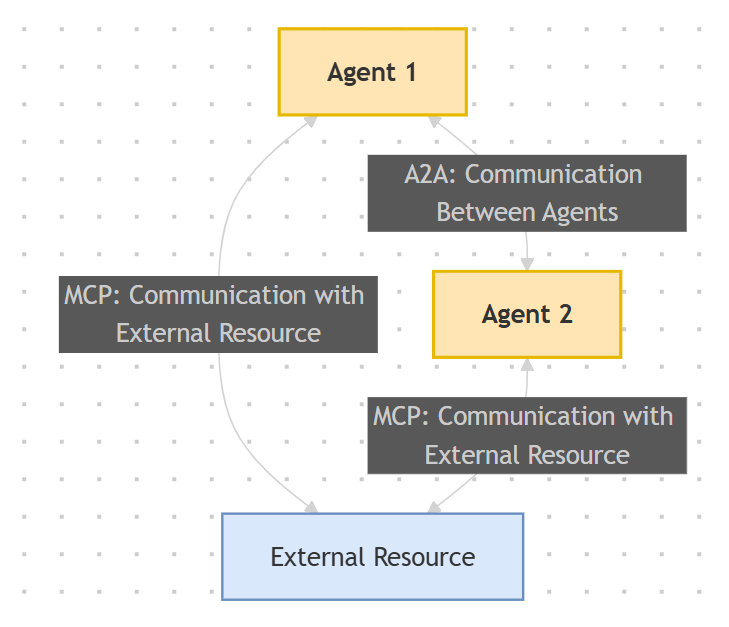A2A and MCP: The Future of Communication Between AI Agents
Uncovering Once and for All the Difference Between A2A and MCP
As AI systems become more autonomous and distributed, the need to standardize how these agents communicate and share resources grows.
Two recent proposals have stood out in this context: the Agent2Agent (A2A) protocol, introduced by Google, and the Model Context Protocol (MCP), developed by Anthropic (learn more here).
These two protocols address different – yet complementary – aspects of agent interaction, laying the foundation for a more collaborative and interoperable ecosystem.
The Problem: Automation Silos
The current state of corporate AI mirrors the early days of the cloud: powerful solutions, but isolated. There is a lack of interoperability. There is a lack of coordination.
The result? Manual processes, fragile integrations, and workflows with little or no dynamism.
This is where A2A and MCP come in, with an audacious proposal: to transform agents into true autonomous and collaborative digital teams.
A2A: The Universal API for Agents
Agent-to-Agent is a proposal by Google to standardize how AI agents exchange messages, tasks, and results. Think of it as a REST API, but designed for agents.
It provides clear rules for an agent to discover another, understand its capabilities, negotiate the output format, divide tasks, and keep the conversation going, even over multiple interactions.
The great insight of A2A is its construction based on widely used web technologies like HTTP, JSON-RPC, and Server-Sent Events (SSE), making it easier for developers to adopt and integrate with existing systems.
Key components:
Agent Cards: A "digital business card" that enables the discovery of other agents and their capabilities.
Tasks and Artifacts: Tasks with a well-defined lifecycle and standardized results.
Parts and Messaging: Support for modular messages with text, files, images, or JSON.
Asynchronous communication: Real-time updates via SSE and push notifications.
The design is elegant: each agent is autonomous, with its own identity, capabilities, and permissions.
MCP: Efficient Context Sharing
The MCP, on the other hand, aims to solve a different problem: how to provide agents with standardized access to tools, APIs, and knowledge bases.
It allows different models or agents to share resources and access external functionalities in an organized and secure manner.
While A2A focuses on communication between agents, the Model Context Protocol addresses how AI models access external data and tools. It acts as a universal connector, providing a standardized interface for complex interactions.
How it works:
MCP Clients: typically the agents themselves or applications that need to access data.
MCP Servers: represent tools, databases, and services that expose their functions via the protocol.
MCP also supports persistent bidirectional communication (WebSocket-style), allowing real-time updates and continuous operation. It organizes resources into three levels:
Prompts (user-controlled),
Resources (application-controlled),
Tools (model-controlled).
How do they complement each other?
Simple: MCP operates in the data plane, and A2A operates in the control plane.
Imagine the following scenario:
An orchestrator agent uses A2A to trigger specialized agents.
Each specialized agent uses MCP to fetch the necessary data and tools.
The results are coordinated and shared via A2A, in a fluid collaboration network.
This architecture creates intelligent and highly automated ecosystems, with specialization and collaboration between agents.
What Does This Mean for DevOps and AIOps?
The revolution comes with new possibilities — and responsibilities.
Distributed orchestration: Dynamic workflows with multiple agents working in parallel.
Enhanced observability: Communication standards make it easier to use existing monitoring tools.
Built-in security: A2A comes with integrated authentication and authorization.
New DevOps skills: The selection, deployment, orchestration, and management of autonomous agents become part of the scope.
An example?
In AIOps, a monitoring agent might detect an incident (MCP), trigger a triage agent (A2A), which then queries a database (MCP), and requests fixes from another agent (MCP), all under the guidance of a coordinator who oversees and documents the process (A2A).
The Protocols War?
Despite the talk of complementarity, some argue that a "protocol war" may arise.
Some experts believe that MCP could lose ground if companies decide to expose their platforms directly as A2A agents - taking advantage of the native security and control features that A2A already offers.
In any case, it’s a debate that promises to heat up the AI backstage in the coming years.
Conclusion: The Era of Collaborative Intelligence
A2A and MCP are more than just protocols.
They are the foundations for a new paradigm of orchestration based on intelligent agents. When combined, they offer a clear path for building truly autonomous, integrated, and scalable systems.
And for us, AI and DevOps professionals, this represents an invitation: to learn, experiment, and lead this transformation!
I hope you enjoyed the article! See you in the next edition 😉




